Abstract
The purpose of this study was to examine consumers' behaviors toward ready-to-eat foods and to develop ready-to-eat food market segmentation in Korea. The food-related lifestyle and purchase behaviors of ready-to-eat foods were evaluated using 410 ready-to-eat food consumers in the Republic of Korea. Four factors were extracted by exploratory factor analysis (health-orientation, taste-orientation, convenience-orientation, and tradition-orientation) to explain the ready-to eat food consumers' food-related lifestyles. The results of cluster analysis indicated that "tradition seekers" and "convenience seekers" should be regarded as the target segments. Chi-square tests and t-tests of the subdivided groups showed there were significant differences across marital status, education level, family type, eating-out expenditure, place of purchase, and reason for purchase. In conclusion, the tradition seekers consumed more ready-to-eat foods from discount marts or specialty stores and ate them between meals more often than the convenience seekers. In contrast, the convenience seekers purchased more ready-to-eat foods at convenience stores and ate them as meals more often than the tradition seekers. These findings suggest that ready-to-eat food market segmentation based on food-related lifestyles can be applied to develop proper marketing strategies.
In Korea, 49.5% of total food expenditures are spent at various eating out establishments, such as restaurants, foodservice outlets, and chain food stores [1]. Particularly, among many eating-out menus, there has been remarkable growth in sales of ready-to-eat foods (RTE foods) such as kimbop, sushi, sandwiches, hamburgers, and salads.
According to the Korean Food Code [2], ready-to-eat foods are typically processed to ensure that they are safe to consume without further cooking. Additionally, by the Australia New Zealand Food Standards Code, an RTE food refers to a food that is ordinarily consumed in the same state as that in which it was sold or distributed, and does not include nuts in the shell or whole, raw fruits and vegetables that are intended for hulling, peeling, or washing by the consumer [3]. It is important for marketers to understand the reasons behind the high demand for RTE foods. In particular, previous literature has shown that the increasing demand for RTE foods could be largely attributed to changes in socio-demographic characteristics and consumer lifestyles [4-8].
Lifestyle refers to the distinctive ways in which a set of consumers spend their time, what they consider important, what their opinions are about current issues [9]. Food market segmentation based on lifestyle can be applied to develop proper marketing strategies for each segmented market. In the food domain, many segmentation variables have been applied such as demographic, socio-demographic, and psychographic or lifestyle profile [9,10]. However, one of the most elaborate segmentation tools in the field of food research is the food-related lifestyle instrument [11].
The food-related lifestyle scale was developed by Brunsǿ & Grunert [12]. Following their research, the applicability of the food-related lifestyle scale was proven through several studies [6-8,13-15]. Lifestyle is inextricably linked to values and the processes by which people seek to achieve their values through various modes of expression, including the consumption of food products. To better understand this process, this study adopted a food-related lifestyle instrument for segmenting the Korean domestic RTE food market.
Effective marketing focuses upon creating a product that meets customers' wants and needs [16,17]. Therefore, identifying and understanding the customer are strategies that vendors can use to optimize their market [18]. To establish marketing strategies, the first step is market segmentation. Schiffman et al. [19] defined market segmentation as "the process of dividing a potential market into distinct subsets of consumers and selecting one or more segments as a target to be reached with a distinct marketing mix."
Basically, the need for segmentation results from the differences between people, where if no such differences existed, only mass marketing strategies would need to be used [9]. The justification for segmenting consumer markets is that consumers who share similar characteristics will share similar attitudes, wants, and needs. Thus, they will have similar behavioral responses towards marketing stimulation [20,21]. Therefore, a better understanding of consumer attitudes and behaviors towards RTE foods is necessary in developing effective marketing strategies.
Previous studies on RTE foods in Korea have mostly focused on microbiological assessments [22,23]. Although Korea has a growing demand for RTE foods, no information is available regarding marketing strategies for RTE foods [24,25]. Therefore, this study aimed to fill this gap by examining RTE food consumers' attitudes and behaviors and to profile RTE food consumer lifestyle segments in Korea. The findings of this study provide information on how the industry can communicate more effectively with their targeted segments.
The survey instrument was developed based on previous studies [12,14,26-29]. The questionnaire also took cultural differences into consideration since it was designed for Korean subjects. The questionnaire consisted of two sections to investigate the food-related lifestyle and socio-demographic characteristics of the consumers. The sixteen food-related lifestyle items were estimated by a five-point Likert-type scale, ranging from strongly disagree (1) to strongly agree (5).
A pilot test was performed with 30 RTE food consumers. Based on the results of the pilot test, the questionnaire was modified. Face validity was assessed through a pilot-test conducted to refine the survey instrument.
The finalized questionnaire was distributed to 480 consumers who had previously purchased RTE foods in the city of Daegu and Gyeongbuk province in the Republic of Korea and collected by the researcher or a mail within two weeks. Out of the 480, 418 questionnaires were collected, resulting in a response rate of 87.1%. After deleting incomplete responses, 410 responses were finally applied for data analysis.
All statistical analyses were conducted using the SPSS 14.0 statistical software program. Frequency analysis was conducted first to examine the characteristics of the respondents. Then, sixteen food-related lifestyle items were subjected to exploratory factor analyses (EFA) with Varimax rotation to reduce the items to a smaller, more parsimonious set of variables, and to delineate the common characteristics of the consumers' food-related lifestyles. Eigenvalue and factor loading scores were used to identify the number of factors to extract [30]. The exploratory factor analysis (EFA) with Varimax rotation extracted four discrete factors with eigenvalue higher than 1.0. After EFA, the items exhibiting low factor loadings (<.40) were deleted [30]. Two items that had low-factor loading score were eliminated for the purpose of purification.
After conducting factor analysis, cluster analysis was conducted to obtain information on the number of homogeneous groups represented by the data using the identified factors. Consequently, cluster analysis was performed using four identified food-related factors to segment the consumers. Additionally, significant differences were identified for the cluster based on Chi-square tests and t-tests.
Table 1 presents the sample characteristics of the respondents. The results of frequency analysis showed that 42.4% of the respondents were male and 57.6% were female. The respondents varied in age (20-29 years of age = 51.5%; 30-39 years of age = 22.4%; ≥ 40 = 26.1%), and 43.7% of them were married and 56.3% were single.
Table 2 presents the respondents' consumption practices of RTE foods. It shows that they were mainly motivated to purchase RTE foods out of convenience (50.7%). The most common venues to purchase these foods were supermarkets or discount marts (67.6%), followed by specialty stores (24.8%) and convenience stores (7.6%). Specialty stores here are small stores which specialize in a specific range of merchandise and related items such as kimbop, sushi, and sandwiches. The average expense per person for a single purchase of an RTE food product was between 3,000~5,000 Korean won ($2.50~$4.17). In regard to the co-consumers, the largest numbers of consumers consumed RTE foods with family (45.1%) and friends (28.3%). It is also interesting to note that 19.0% of the consumers purchased RTE foods for themselves. Finally, the findings show that the most common source of purchasing information was direct comparisons at the place of purchase.
Table 3 presents the results of the factor structure delineated by exploratory factor analysis. Reliability was assessed to examine the internal consistency of the result measurements. Since the Cronbach's alpha is the most popular measure of reliability for a multi-item scale [31], it was computed to assess the reliability of the extracted factors. The Cronbach coefficients for all extracted factors exceeded the suggested cut-off point of 0.6, ranging from 0.634 to 0.748 [30]. Thus, the results demonstrated the internal consistency of multiple indicators for each construct. Table 3 presents the factors, reliability coefficients, factor loading scores, eigenvalue, and the percentage variance explained. The percentage variance explained by the four factors was 60.8%.
Each factor was named based on the characteristics of its composite variables. These factors were named as follows: "health-orientation" (e.g., I consider fat content when I choose a food) for Factor 1, "taste-orientation" (e.g., The joy of eating is one of the most important things in my life) for Factor 2, "convenience-orientation" (e.g., I frequently buy pre-cooked foods at supermarkets or other locations) for Factor 3, and "tradition-orientation" (e.g., I can not eat well without side dishes, such as soups and stews) for Factor 4.
Factor 1 (health-orientation) consisted of statements that related to the pursuit of health when purchasing food. Factor 2 (taste-orientation) involved consumer attitudes and behaviors about eating-out and price consciousness for meals. Factor 3 (convenience-orientation) dealt with selecting RTE foods or convenience foods and addressing the time invested in meals. Factor 4 (tradition-orientation) was concerned with individual eating patterns for daily meals.
In order to subdivide the RTE food consumers into homogeneous groups, cluster analysis by the K-means method was conducted based on the four identified factors. Table 4 presents the results of cluster analysis by the K-means method based on the food-related lifestyle factors. Significant differences were identified across all 4 factors for the two-cluster solution based on one-way ANOVA. There were no significant differences between Cluster 1 and Cluster 2 in the means of the health-orientation and taste-orientation. On the other hand, there were significant differences between Cluster 1 and Cluster 2 in the means of the convenience-orientation and tradition-orientation.
This resulted in the following two categories. This segmentation structure was relatively stable but continued to evolve as two new market segments were identified, namely "tradition seekers" for Cluster 1 and "convenience seekers" for Cluster 2. Each cluster was labeled according to the characteristics of its composites and the weight of the clustering variables. The "tradition seekers" accounted for 58.5% of the sample and the "convenience seekers" represented 41.5%.
Table 5 presents the demographic profiles of the RTE food segments. The results of the Chi-square tests on the sociodemographic characteristics of the subdivided groups showed significant differences by marital status (P < 0.01), education level (P < 0.01), and family type (P < 0.05).
More tradition seekers lived with family as compared to the convenience seekers, and they also had a greater proportion with a high school education or lower. The convenience seekers were more likely to live alone, and their average education level was significantly higher than that of the tradition seekers. There were no significant differences between the tradition seekers and convenience seekers in the percentages of gender and age.
In addition, the Chi-square test and t-test results indicated that differences existed between Cluster 1 and Cluster 2. Table 6 presents the results of the Chi-square tests and t-tests for RTE foods consumption practices by the subdivided groups. There were significant differences for place of purchase (χ2 = 6.167, P < 0.05), reason for purchase (χ2 = 8.380, P < 0.05), and eating-out expenditures (t = -0.286, P < 0.05) towards RTE foods.
In general, the tradition seekers purchased RTE foods at discount marts or specialty stores and consumed them more as between meal foods than convenience seekers. In contrast, the convenience seekers tended to purchase RTE foods at discount marts or convenience stores and consumed them more as meals compared to the tradition seekers. Additionally, the convenience seekers had significantly higher expenditures than the tradition seekers.
The purpose of this study was to examine RTE food consumers' attitudes and behaviors and to profile RTE food lifestyle segments of consumers in Korea. The results of this study should help RTE food marketers gain better insights into consumers' attitude and behavior patterns towards RTE foods. In addition, this study suggests that RTE food market segmentation based on food-related lifestyles can be applied to develop marketing strategies to better meet consumers' wants and needs, which in turn leads to consumer satisfaction and increased sales of RTE foods.
According to the survey results for RTE food consumer behaviors, the biggest purchase motivator for RTE foods was convenience (50.7%). This is similar to the Chae et al. [24] finding from a survey targeting university students and another result of previous study [32] about the purchase motivation of convenience food. Approximately 67.6% of the respondents bought RTE foods in supermarkets or discount marts, and 70.5% bought RTE foods at meal times. This result shows that most of the respondents purchased RTE foods for meals. Therefore, manufacturers of RTE foods should develop proper one-portion size meals. In addition, the most common source of purchasing information was direct comparison at the place of purchase (64.6%). Therefore, marketers of RTE foods should implement sales promotions within product sections of each store.
Exploratory factor analysis extracted four factors (health-orientation, taste-orientation, convenience-orientation, and tradition-orientation) to explain the ready-to-eat food-related lifestyles. According to Kim et al. [33], in order to assess the selection attributes of restaurants, five factors were obtained by factor analysis of food-related life styles of undergraduates in Korea. Two out of five factors were named: "health seeking type" and "taste seeking type". The two factors were similar to the results of this study.
The results of cluster analysis identified two completely different food-related lifestyles: tradition seekers and convenience seekers. Some previous studies have largely ignored the segment of "traditionalists" [14]. However, unlike earlier studies, the findings of this study suggest that tradition seekers should be considered an important target market of RTE foods. Despite modernization of society, as 58.5% of the respondents, the tradition seekers were set in their eating patterns. It is very important to note that this study found that Koreans still have a tendency to consume RTE foods with tradition-minded purposes. Therefore, manufacturers of RTE foods in Korea should try to develop traditional menu items.
There is no doubt that demographic and psychographic segmentation is commonplace and consumer lifestyle variables are being used by marketers due to the insight they can provide on target markets [34,35]. Psychographic research originally focused on individual behaviors, interest, and opinions. Also, to measure lifestyles it was necessary to add demographics as a fourth dimension [14,19,36].
The following previous studies were performed based on socio-demographic characteristics and the food-related lifestyles of consumers. Buckley et al. [29] derived four consumer segments toward convenience foods, such as "food connoisseurs (26%)", "home meal preparers (25%)", "kitchen evaders (26%)", and "convenience-seeking grazers (32%)". In addition, Wycherley et al. [11] divided six food-related lifestyle segments for specialized foods, for example, "rational food consumer (24%)", "adventurous food consumer (17%)", "careless food consumer (21%)", "snacking food consumer (17%)", "conservative food consumer (12%)", and "uninvolved food consumer (9%)". The findings of this study also reinforced the usefulness of consumers' socio-demographic characteristics and food-related lifestyle to better understand their different consumption patterns of RTE foods.
Lin [35] claimed that demographic segmentation could be used as one of the main variables for the purposes of market segmentation and targeting. According to the results of this study, more tradition seekers lived with family as compared to the convenience seekers, and also had a greater proportion of respondents with a high school education or lower. The convenience seekers were more likely to live alone, and their average education level was significantly higher than that of the tradition seekers.
Kupiec and Revell [37] suggested that education and income can be used as fundamental variables when segmenting food markets. The results of the Chi-square tests on the sociodemographic characteristics of the subdivided groups showed significant differences in terms of education level. However, no significant differences were found among different income levels. These findings suggest that income level is not a major variable when segmenting RTE food markets in Korea. This result may be caused by the low to medium prices of RTE foods in Korea.
The results showed that tradition seekers purchased RTE foods at discount marts (65.4%) or specialty stores (28.8%) and consumed them more between meals than convenience seekers. These findings suggest the need to develop RTE food products for between meals targeting traditional seekers. Furthermore, the results recommend that products should be promoted at discount marts or specialty stores, particularly for tradition seekers versus convenience seekers, in Korean.
The convenience seekers also purchased RTE foods at discount marts (70.6%) and specialty stores (19.4%) more often than at convenience stores (10.0%). However, they more bought RTE foods at convenience stores (5.8%) than the tradition seekers. Additionally, the convenience seekers more often consumed RTE foods as meals compared to the tradition seekers. Therefore, when targeting convenience seekers, manufacturers should develop RTE food products that can be served as meals. In addition, these products should be promoted at discount marts or convenience stores.
There were no significant differences in RTE food consumption practices between the tradition seekers and convenience seekers by purchase motivation, decision maker for purchasing, and co-consumers. In addition, the convenience seekers spent more money on eating-out compared to the tradition seekers. However, the two groups' average expenditures for RTE foods were not significantly different with 4,887 Korean won ($ 4.07) for the convenience seekers and 4,927 Korean won ($ 4.11) for the tradition seekers. Therefore, manufacturers and marketers of RTE foods should understand and meet consumer wants and needs and provide products with proper prices at main sites of purchase.
The findings of this study indicate that consumer behaviors towards RTE foods differed between segments, and RTE food market segmentation based on food-related lifestyles can be applied to develop proper marketing strategies.
The limitations of this study are as follows. The data were collected using a convenience sampling approach that decreased the external validity of the results. Also, the residence area of the respondents was limited to only one part of the Republic of Korea. Thus, future studies should consider developing a systematic design to better represent the population.
Figures and Tables
References
1. Korea Statistics [Internet]. 2008. cited 2009 December 30. Seoul: Statistical Yearbook;http://www.kostat.go.kr/nso_main/nsoMainAction.do?method=search&catgrp=nso2009&catid1=k09_0000&catid2=k09i_0000&forward=search.
2. Korea Food and Drug Administration [Internet]. 2009. cited 2009 December 30. Seoul: Korean Food Code;Available from: http://kfda.go.kr/daegu/index.kfda?mid=53&seq=6988&cmd=v.
3. Food standards Australia New Zealand [Internet]. 2001. cited 2009 December 30. New Zealand: Food Standards code;Available from: http://www.foodstandards.gov.au/foodstandards/foodstandardscode/.
4. Verbeke W, Lopez GP. Ethnic food attitudes and behaviour among Belgians and Hispanics living in Belgium. British Food Journal. 2005. 107:823–840.

5. Ambler T, Bhattacharya CB, Edell J, Keller KL, Lemon KN, Mittal V. Relating brand and customer perspectives on marketing management. Journal of Service Research. 2002. 5:13–26.

6. Mattila AS. Consumer behavior research in hospitality and tourism journals. International Journal of Hospitality Management. 2004. 23:449–457.

7. Hoek AC, Luning PA, Stafleu A, de Graaf C. Food-related lifestyle and health attitudes of Dutch vegetarians, non-vegetarian consumer of meat substitutes, and meat consumers. Appetite. 2004. 42:265–272.

8. Marie B, Cowan C, McCarthy M. The convenience food market in Great Britain: convenience food lifestyle segment. Appetite. 2007. 49:600–617.

9. Blackwell RD, Miniard PW, Engel JF. Consumer behavior. 2001. 9th ed. Florida: Harcourt Inc.
10. McCarthy M, Henson S. Perceived risk reduction strategies in the choice of beef by Irish consumers. Food Qual Prefer. 2005. 16:435–445.

11. Wycherley A, McCarthy M, Cowan C. Speciality food orientation of food related lifestyle segments in Great Britain. Food Qual Prefer. 2008. 19:498–510.

12. Brunsǿ K, Grunert KG. Development and testing of a cross-culturally valid instrument: food-related life-style. Adv Consum Res. 1995. 22:475–480.
13. Brunsǿ K, Grunert KG, Bredahl L. MAPP, Working Paper, No.35. An analysis of national and cross-national consumer segments using the food-related lifestyle instrument in Denmark, France, Germany and Great Britain. 1996. Arahus: School of Business, Arahus.
14. Kesic T, Piri-Rajh S. Market segmentation on the basis of food-related lifestyles of Croatian families. British Food Journal. 2003. 105:162–174.

15. Scholderer J, Brunsǿ K, Bredahl L, Grunert KG. Cross-cultural validity of the food-related lifestyles instrument (FRL) within Western Europe. Appetite. 2004. 42:197–211.

16. Kotler P, Bowen JT, Makend JC. Upper saddle river. Marketing for Hospitality and Tourism. 2010. USA: Prentice-Hall;263–281.
17. McColl-Kennedy J, Kiel G. Marketing: A Strategic Approach. 2000. Melbourne: Nelson Thomson Learning.
18. Seaton AV, Bennett MM. Marketing Tourism Products. 1996. London: International Thomson Business Press.
19. Schiffman LG, Kanuk LL. Consumer Behavior. 1987. 3rd ed. New Jersey: Prentice Hall;30–59.
20. Ahma J. Retailing in a multicultural world: the interplay of retailing, ethnic identity and consumption. Journal of Retailing and Consumer Services. 2003. 10:1–11.

21. Dibb S, Simkin L. Market Segmentation: Diagnosing and Treating the Barriers. Industrial Marketing Management. 2001. 30:609–625.
22. Bae HJ, Park HJ. Hazard analysis of Staphylococcus aureus in ready-to-eat sandwiches. Journal of the Korean Society of Food Science and Nutrition. 2007. 36:938–943.

23. Park SY, Choi JW, Yeon JH, Lee MJ, Lee DH, Kim KS, Park KH, Ha SD. Assessment of contamination levels of foodborne pathogens isolated in major RTE foods marketed in convenience stores. Korean Journal of Food Science and Technology. 2005. 37:274–278.
24. Chae MJ, Bae HJ, Yoon JY. Consumption practices and selection attributes of the university students on ready-to-eat foods. J Foodserv Manage. 2008. 11:289–307.
25. Chae MJ, Bae HJ. A survey on preference and satisfaction of the customers purchasing ready-to-eat foods. Korean Journal of Food and Cookery Science. 2008. 24:788–800.
26. Grunert K, Brunso K, Bredahl L, Bech AC. Food-related lifestyle: A segmentation approach to European food consumers. 2001. London: Springer.
27. Ryan I, Cowan M, McCarthy M, O'Sullivan C. Segmenting Irish food consumers using the food-related instrument. Journal of International Food and Agribusiness Marketing. 2004. 14:29–48.
28. Buckley M, Cowan C, McCarthy M, O'Sullivan C. The convenience consumer and food-related lifestyle in Great Britain. Journal of Food Product Marketing. 2005. 11:3–25.
29. Buckley M, Cowan C, McCarthy M. The convenience food market in Great Britain: convenience food lifestyle (CFL) segments. Appetite. 2007. 49:600–617.

30. Hair JF, Anderson RE, Tatham RL, Black WC. Multivariate data analysis. 1998. New Jersey: Prentice Hall.
31. Sekaran U. Research methods for business: A Skill-building Approach. 1992. New York: Wiley.
32. Kim HY, Jeong SJ. Dietary behavior of college students in Kangreung area on convenience food. Korean Journal of Food and Cookery Science. 2002. 18:440–447.
33. Kim MJ, Jung HS, Yoon HH. A study on the relationships between food-related lifestyle of undergraduates and the restaurant selection attribute. Korean Journal of Food Culture. 2007. 22:210–217.
34. Grunert KG, Brunsø K, Bisp S. MAPP working paper 12. FRL: Development of a cross-culturally valid instrument for market surveillance. 1993. Arahus: Arahus School of Business.
35. Lin CF. Segmenting customer brand preference: Demographic or psychographic. Journal of Product and Brand Management. 2002. 11:249–268.

36. Boste A. Interaction in psychographics segmentation: implication for advertising. J Advert. 1984. 4–48.




 PDF
PDF ePub
ePub Citation
Citation Print
Print


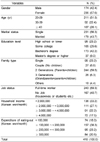
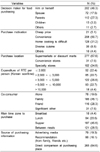
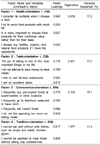

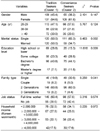
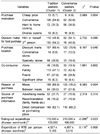
 XML Download
XML Download